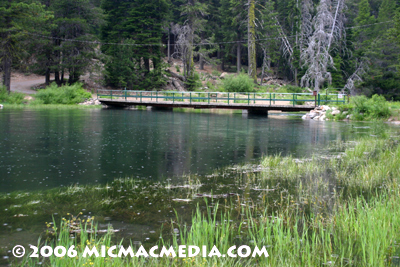|
Tahoe Nugget #89:
A Watermaster Controls the Truckee
July 7, 2006
Thursday before July 4th weekend this year, tourists were in Tahoe full force, yet the Truckee River out of Tahoe City was running so high that commercial rafting was shut down for safety issues. Big money loss, but
in fact the water level was so high that the rafts and their passengers would never be able to squeak under a couple bridges on that section of the river. See photo #1.
Garry Stone is the federal watermaster
whose office controls the 17 gates of the Tahoe dam, the huge lake's only outlet. See Tahoe Nuggets #9 & #10 for flow dynamics. The Truckee River watermaster must follow prescribed rules in an attempt to
balance the ever tricky nuances of Sierra weather, snowpack runoff and water policy.
This week, a minimal water release through the Tahoe dam has again shot down commercial rafting on the Truckee River during the busy season. The flow is now too low. Businesses such as the two Truckee River rafting companies sink or swim financially based on water flows produced by the policy-controlled Tahoe Outlet Dam. I am told that the rafting companies can only operate within certain designated river flows, high or low, which are based on cubic feet per second values. Their prime economic season is effectively less than 15 weeks long; so every day counts. Ultimately, the river is controlled according to water rights established over the last century or more and they include Nevada utilities and water districts which represent rapidly growing communities.
Empirical evidence suggests that the river environment suffers less damage and trash impact when the rafting businesses are in operation. I rode my bike along the Truckee River today and saw couples and families enjoying a splendid trip on their personal rafts and kayaks. I also saw full trash cans and the first of what most likely will be a scattering of abandoned rafts. I'm expecting that the raft companies will still keep an eye on trash buildup along the approximately 5 mile float down the Truckee's headwaters.
Currently Lake Tahoe is less than one inch below its legal maximum elevation (6 feet of water storage), yet the rafting companies can only eye that water behind the dam with envy since it is stored mainly for agricultural and municipal use for people and places many miles away. According to the rules of prior appropriation (western water law), which focuses on "first in time, first in right," the rafting companies are way down the line in water rights.
The unpredictable nature of rivers can sometimes be enhanced or exacerbated by human/policy management.
Photo #1: View of a Truckee River bridge on June 28 during the second day of a 48-hour period of scattered showers. Note that the water is too high for rafters to safely pass, let alone other safety issues.
Although it is raining in this photograph, the high water is due to the exceptional snowmelt runoff from last winter, not from any recent precipitation.
Photo #2: A family going under the same bridge today on a
personal raft.
Photo #3: No business with Tahoe City rafting companies out of work.
Photo #4: Kayak is one way to go.
Photo #5: Not only is the wife paddling, it appears he has his stash in tow.





|







